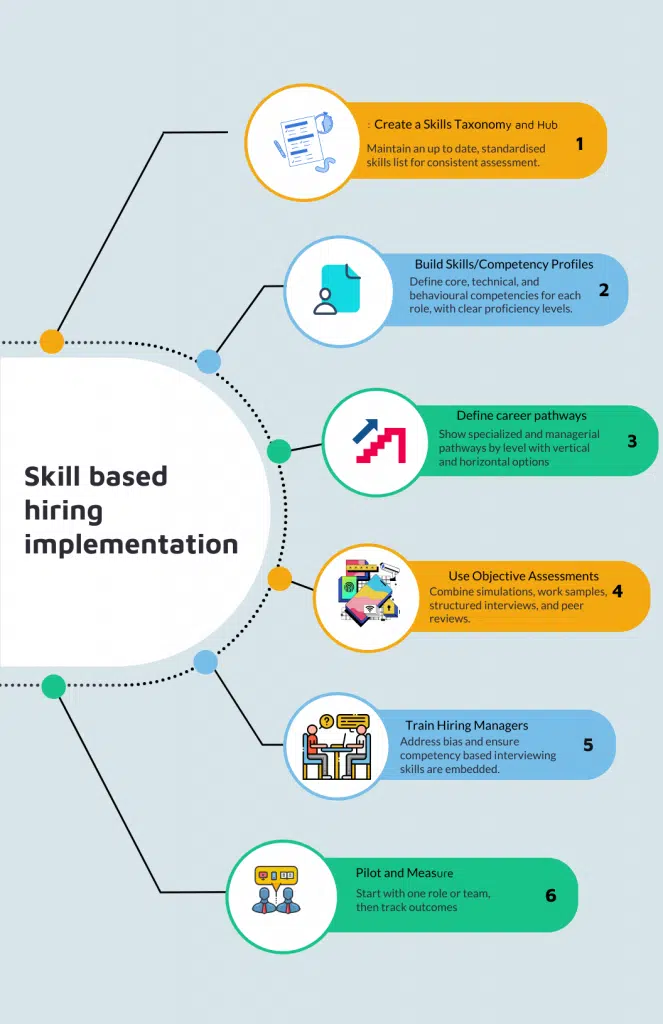Skills‑Based Hiring: Why Competency Is the New Currency
Most companies say they want to hire for skills. Few actually do.
Harvard Business School research shows that while degree requirements are disappearing from job ads, fewer than 1 in 700 hires are made on a skills only basis. The gap? A lack of clear competencies, objective assessments, and manager readiness.
In this guide, we break down the what, why, and how of skills based hiring — backed by the latest economics and talent research — and show you how to make it work inside your organisation.
What is Skills Based Hiring?
Skills‑based hiring (also known as skills‑first or competency‑based hiring) focuses on what candidates can actually do, rather than their degrees, job titles, or time in a previous role. It relies on assessments of both technical (hard) skills and relevant soft skills— for example problem‑solving, communication, adaptability—to determine suitability for a given role.
The Skills First Shift — and the Reality Check
Skills based hiring is often portrayed as the future of recruitment: selecting candidates on their demonstrated competencies rather than degrees or years in a role.
Yet research from Harvard Business School (2023) shows that while many companies publicly drop degree requirements, only ≈1 in 700 hires in 2023 were truly skills only hires — and just 37% of firms that made the change followed through with meaningful process shifts (Fuller, Raman, & Bughin, 2023). The rest either saw no measurable change (45%) or eventually reverted to credential bias (18%).
Key takeaway: Removing a degree requirement from a job ad is not the same as hiring for skills. Without competency frameworks, assessment tools, and manager enablement, there will be no advantage.
Why Skills Matter
Larger Talent Pool
Skills Based hiring enables you to expand the size and diversity of the talent pool you draw from, internally as well as externally. By including more non degree and female technical workers. According to Linked In research this could expand the talent pool up to 6 fold and even more – up to 8 fold for AI roles. Female applicants could increase by up to 24%. According to some reports internal mobility is on the rise as organizations look to upskill their workforces.
Improves Retention, Performance & ROI, Reduces risk.
Non degreed workers are likely to stay longer, as are those who have advanced internally. According to TestGorilla’s 2025 State of Skills based Hiring Report , 60% of those using this approach report better performance from their hires.
Deloitte’s 2022 Survey found that those using skills based approaches were 98% more likely to retain skilled workers.
Higher Efficiency, Lower Costs
Those using a skill based approach and online skills screening platforms, report less time to hire, less training needed and lower costs – estimates vary between 25-75% – according to providers of screening platforms. The Deloitte survey found that those using skills based approaches were 107% more likely to place their workers effectively.
Agility
Skills based organizations are 57% more likely to respond effectively to change according to Deloitte.
The value of skills
Decades of research into ‘Skills Economics’ shows that the value of skills is directly related to supply and demand, and also to skills communities such as Finance and Technology. There is clear evidence that core skills are in demand – especially social and critical thinking skills and that these deliver higher rewards than would be predicted based on qualifications alone.
In fact network analysis studies of those with a variety of hard and soft skills- “skill complementarity” show they are more valued. In AI related skills those with strong cognitive and social skills can command up to 20% salary premium. (Stephany & Teutloff, 2022).
Katharine Anderson (2017) found that workers with diverse skill sets – the ability to do more than one job – are considered more valuable.
Internal Hiring: Where the Real Opportunity Lies
For many organisations — especially those without a large external recruitment arm — the fastest wins are internal.
- Retention boost: Internal hires have 10–20 percentage point higher two year retention than external hires (LinkedIn, 2022).
- Time to fill savings – when staff are on hand its quick and easy to do thorough knowledge & skills assessments
- Agility: Skills based organisations are 57% more likely to adapt effectively to change (Deloitte 2022).
By mapping competencies across your existing workforce, you can uncover hidden talent for lateral moves, promotions, or redeployment — without the cost and risk of external hiring.
Who Benefits from This Approach?
- HR & Talent leaders gain better internal pipelines and succession visibility.
- Hiring managers can match current staff to new roles via transparent competency maps.
- Employees get clarity on career paths and can self-nominate based on skills, not tenure.
Many leading companies, notably Salesforce, are using AI-powered internal mobility tools – such as AI coaches and recommendations. Business Insider reports 50% of roles in Q1 2025 were filled internally via their AI-driven platform—and 74% of users engaged with it.

When & Where to Apply It
Apply skills based hiring:
- During internal transfers, promotions, or redeployment.
- In roles ripe for upskilling—sales, service, digital-marketing, tech‐adjacent functions.
- When traditional degree filters exclude ideal candidates.
It’s especially impactful when:
- You use internal skills inventories or competency maps.
- You’re looking for more equity and diversity in promotion and mobility processes.
Which roles are most suitable?
☑️ Use it across jobs with transferable skills
- customer service
- digital marketing
- tech – eg. data analyst, UI/UX designers
- project management
- internal mobility spots – cross functional, AI related, upskilling roles
Skills based hiring is obviously not suitable for roles requiring regulated credentials (medicine, nursing, allied health, trades, law, licensed engineering)
How to Implement Skills Based Hiring Internally
1️ Create a Skills Taxonomy
Maintain an up to date, standardized skills list for consistent assessment.
2️ Build Competency Profiles & Career Pathways
Define core, technical, and behavioral competencies for each role, with clear proficiency levels.
3️ Use Objective Assessments
Combine simulations, work samples, structured interviews, and peer reviews.
4️ Train Hiring Managers
Address bias and ensure competency based interviewing skills are embedded.
5️ Pilot and Measure
Start with one role or team, then track:
- Internal vs external fills
- Time to fill
- Retention rates
- Diversity shifts
Pitfall to avoid:
“In name only” adoption — The Harvard Business School research shows most organisations that fail here have no structured governance or accountability for skills based processes.

Why Competency Management Is the Enabler
The most effective skills based hiring leaders have one thing in common: a robust competency management system that makes skills visible, measurable, and actionable.
With Centranum, you can:
- Maintain dynamic skills inventories
- Map competencies for every role or project
- Integrate assessments into hiring and mobility workflows
- Track outcomes for accountability
FAQs
What are the main benefits of skills‑based hiring?
It can expand your candidate pool by up to 8× (especially in tech roles), increase female representation by up to 24%, and help internal hires stay 10–20 percentage points longer. Structured skills processes also typically reduce cost-per-hire and speed up productivity. (LinkedIn 2025; LinkedIn 2022
What steps are essential for successful implementation?
Define role-specific competencies, build and maintain a skills taxonomy, use objective assessments (e.g. simulations and interviews), train managers on bias-aware evaluation, then pilot one role and measure outcomes. Addressing process gaps is key. (SHRM “Designing a No‑Fuss Skills‑Based Hiring Process” 2025)
What does research say about impact?
Harvard Business School found that removing degree requirements rarely changes hiring outcomes—only about 1 in 700 hires are truly skills‑based and only 37% of firms that attempted change saw real progress. (Fuller, Raman & Bughin 2023) This is because skills based hiring depends on other skill based processes and technical infrastructure such as skills hubs.
How does skill based hiring help with internal mobility?
Competency mapping surfaces staff ready for development or lateral moves, making hiring faster, more equitable, and boosting retention and engagement. Internal hires also tend to perform better. (LinkedIn 2022)
What pitfalls should be avoided?
Avoid just dropping credentials without redesigning role architecture or assessment. Lack of manager training, vague job profiles, or poor governance often lead to negligible change. (HBS 2023)
References
1. Fuller, J., Raman, M., & Bughin, J. (2023). Skills-Based Hiring: The Long Road from Pronouncements to Practice. Harvard Business School, Managing the Future of Work.
2. LinkedIn. (2022). Global Talent Trends Report.
3. LinkedIn Economic Graph. (2025). Skills-Based Hiring: Expanding the Talent Pool.
4. SHRM 2025 – Designing a no fuss Skills based hiring process
5. Deming, D., & Silliman, M. (2024). Skills and Human Capital in the Labor Market (NBER Working Paper 32908).
6. Deming, D. (2017). The Growing Importance of Social Skills in the Labor Market. Quarterly Journal of Economics, 132(4), 1593–1640.
7. Stephany, F., & Teutloff, O. (2022). What Is the Price of a Skill? The Value of Complementarity. arXiv:2210.01535.
8. Anderson, A., et al. (2017). Skill Networks and Measures of Complex Human Capital. PLoS ONE, 12(12).
9. World Economic Forum. (2025). Putting Skills First: Opportunities for Building Efficient and Equitable Labour Markets.

